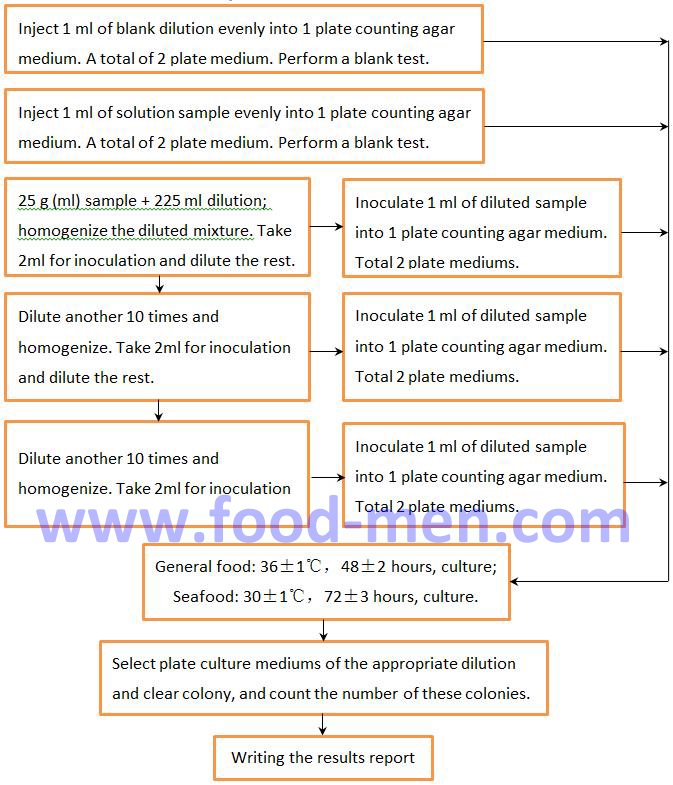Method of Aerobic Plate Count
Published date and time: 2020-09-25, 16:28
Date and time of modification: 2021-05-07, 16:30
Author: Food-Men
This article introduces the method of aerobic plate count in food and the production of the medium of aerobic plate count, to meet the needs of the microbial testing in food.
1. Principle of Aerobic Bacteria Plate Counting Method
Bacteria are so small that they are hard to see with the naked eye. But after they are cultured, they grow from a single bacterium to a colony, and these colonies are easy to see and count. When calculating the microorganisms present in a food, the food is first homogenized. Starting from the original sample concentration, add the dilution solution one by one to dilute the sample, dilute 10 times each time. Before and after each dilution, take the diluted sample and inject it evenly into the plate medium. Then, the microorganisms are cultured under certain conditions (such as a suitable medium, oxygen, temperature, time, pH, etc.), and the number of colonies in the plate medium is calculated. The number of colonies can reflect the content of aerobic microorganisms and the degree of microbial contamination in food. This method of culturing and counting aerobic microorganisms in food is called "aerobic plate count". The aerobic plate count method can detect the degree that food is contaminated by microorganisms.
2. Procedure of Aerobic Plate Count Method
 3. Calculation of Aerobic Plate Count
3. Calculation of Aerobic Plate Count
3.1 Use a magnifying glass or an automatic colony counter to observe and count the colonies on the plate culture medium.
3.2 Expressed as "colony-forming units, CFU".
3.3 Select the plate culture medium with colonies between 30 CFU to 300 CFU without abnormal colonies to count the number of colonies. The plates below 30 CFU recorded in true colony counts, and the plates above 300 CFU recorded as "too numerous to count (TNTC)". The number of colonies for each degree of dilution shall be the average of two plates.
3.4 Calculation formula: N = ∑c / [(1 × n1) + (0.1 × n2)] × d
In the formula:
N ---- the number of colonies per gram or milliliter of the sample;
∑c ---- the sum of the number of colonies on the plate that can be counted;
n1 ---- the number of plate that can be counted in the first degree of dilution ;
n2 ---- the number of plate that can be counted in the second degree of dilution ;
d ---- The lowest dilution of the count.
4. Cautions for Aerobic Plate Count Method
(Click on the blue font to browse another page to view the relevant introduction)
4.1 All tools that contact the contents of the sample should be sterilized by Horizontal Laboratory Autoclave Sterilizers or Vertical Laboratory Autoclave Sterilizers.
4.2 The operation of the sample opening or after opening the lid shall be carried out in an air-cleaned environment, that is aseptic operation. The aseptic operation can be performed in a sterile laboratory (clean room) or clean benches.
4.3 If the contents are a mixture of solid and liquid, put them in Sterile Sample Blender Bags, seal the bags, pat with stomacher blenders, break the solids of the contents, and then inspect.
4.4 If the contents are multiple liquids and you want to stir evenly, use a Magnetic Stirrer Mixer with Timer and HotPlate or a 4 Heads Magnetic Stirrer Mixer with HotPlate or Multifunctional Orbital Shaker Incubators for Laboratory, to ensure that there are no contaminated by microorganisms when are stirring.
4.5 A blank test is required (sample test of no microorganisms). When there is a microbe in the blank test, it indicates that there is a problem with the test operation and the result is not credible.
5. Preparation of plate count agar medium
5.1 Ingredients
Tryptone 5.0 g
Yeast extract 2.5 g
Glucose 1.0 g
Agar 15.0 g
Distilled water 1000 ml
5.2 Production method
Add the above ingredients to distilled water and boil to dissolve. Adjust the pH to 7.0±0.2. Put them into test tubes or conical flasks, cover with cotton stoppers, and autoclave at 121°C for 15 min.
6. Note
Most countries have provisions for aerobic plate count method, but the regulations for each country may vary. This article mainly refers to the relevant aerobic plate count method specifications of the People's Republic of China.
——————————————————————
Related Articles
1. Food Commercial Sterility Testing and Equipment
2. Equipment of Aerobic Plate Count
3. Equipment for testing and counting coliforms
4. Canned Preservation Principle (1) - General Knowledge
5. Canned Preservation Principle (2) - Cans Sizes
6. Canned Preservation Principle (3) - 3-piece Cans Resistance Welding
7. Canned Preservation Principle (4) - Cans Double Seam Seal
8. Canned Preservation Principle (5) - The Generation of Vacuum in the Can
9. Canned Preservation Principle (6) - Sterilization of Canned Food
10. Method of Drinking Water Automatic Treatment and Purification
—————————————————————— 